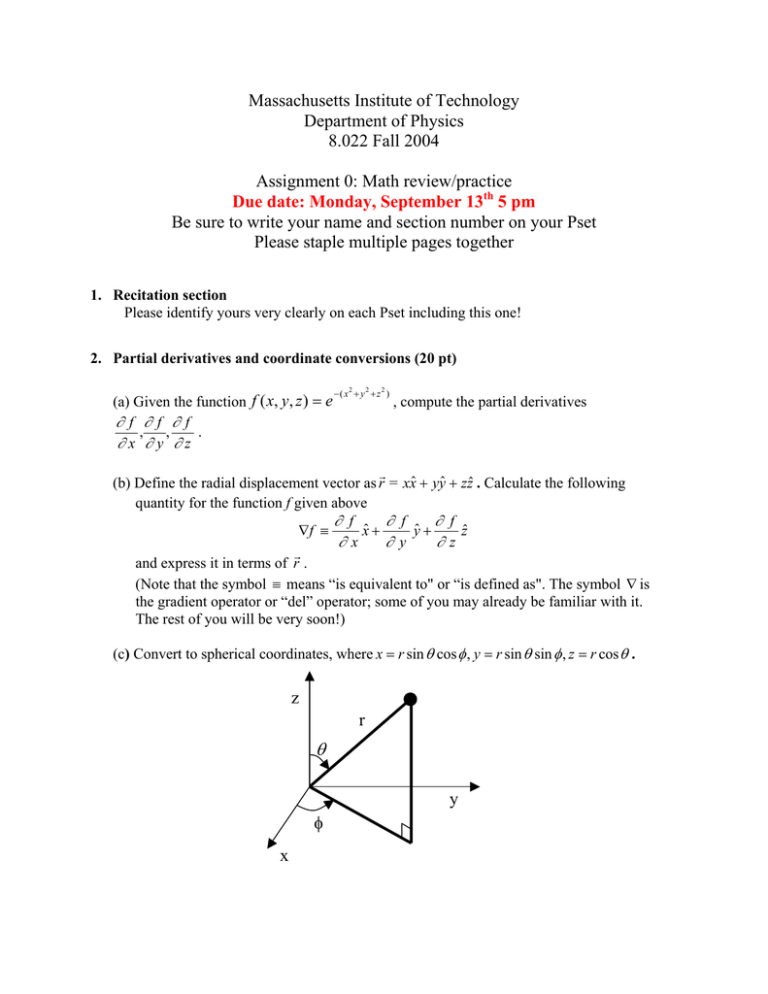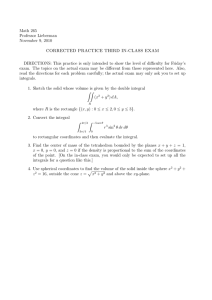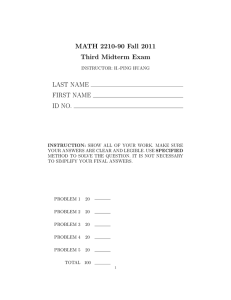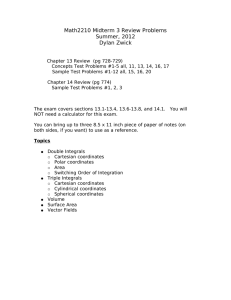Massachusetts Institute of Technology Department of Physics 8.022 Fall 2004
advertisement

Massachusetts Institute of Technology Department of Physics 8.022 Fall 2004 Assignment 0: Math review/practice Due date: Monday, September 13th 5 pm Be sure to write your name and section number on your Pset Please staple multiple pages together 1. Recitation section Please identify yours very clearly on each Pset including this one! 2. Partial derivatives and coordinate conversions (20 pt) (a) Given the function f (x, y, z ) = e ∂f ∂f ∂f , , . ∂x ∂y ∂z −( x 2 + y 2 + z 2 ) , compute the partial derivatives G (b) Define the radial displacement vector as r = xxˆ + yyˆ + zzˆ . Calculate the following quantity for the function f given above ∂ f ∂ f ∂ f ∇f ≡ xˆ + yˆ + zˆ ∂x ∂ y ∂z G and express it in terms of r . G (Note that the symbol ≡ means “is equivalent to" or “is defined as". The symbol ∇ is the gradient operator or “del” operator; some of you may already be familiar with it. The rest of you will be very soon!) (c) Convert to spherical coordinates, where x = r sin θ cos φ , y = r sin θ sin φ , z = r cos θ . z r θ y φ x Express f in terms of r, θ and φ. In spherical coordinates, ∂f 1∂ f ˆ 1 ∂f ˆ φ θ+ rˆ + ∇f = ∂r r ∂θ r sin θ ∂ φ Compute ∇f in terms of r, θ and φ. Compare with your answer to parts (b). Do they agree with each other? G (d) In cylindrical coordinates, we define ρ = xxˆ + yyˆ , tgφ=y/x and leave z untouched: z φ x Write down ∇f = ρ y G G ∂ f ∂ f ∂ f zˆ in terms of ρ , z . yˆ + xˆ + ∂x ∂ y ∂ z (e) Convert to cylindrical coordinates, where x = ρ cos φ , y = ρ sin φ , z = z . Express f in terms of ρ , φ , z hence calculate ∇f in cylindrical coordinates. Are your answers to parts (d) and (e) the same? 3. Line integrals, work, units and dimensional analysis (20 pt) G A force F = A(2 y 2 xˆ + x 2 yˆ ) is acting on a particle that is initially at the origin of the (x, y) coordinate system. We transport the particle on a triangle path defined by the points (0, 0) → (0, l ) → (l , 0) → (0, 0) . The constant A is positive. (a) Suppose we work in SI units: the coordinates (x,y) are measured in meters, so that the particle moves l meters along each leg of the path; the force is measured in Newton. What must be the units of A? Express in terms of kg, m, and s. (b) Suppose we work in cgs units: the coordinates (x, y) are measured in centimeters, and the force is measured in dynes. What must be the units of A? Express in terms of g, cm, and s. (c) How much work does the force do when the particle travels around the path? (Your answer does not depend on the choice of units: express it in terms of the constants A and l, which are assumed to have units built into them). Is this a conservative force? (d) If we place a particle right at the origin, since the total force is zero, the particle will just stay there. Is this a stable situation? Give any argument (mathematical, physical, intuitive) to justify the stability (or instability) of this situation. 4. Multidimensional integrals (20 pt) You wish to calculate the magnitude of the electric potential a distance z on axis above a circular disk that carries surface charge density σ In a few weeks you will learn that the general formula for the potential in this situation is σ φ = ∫ dA r where the integral is taken over the disk, and r is the distance from an element on the disk to the “field point" on the axis. Let us set up the integral in Cartesian coordinates. (a) What is the area element dA? (b) What is the distance r? (c) How many integrals do you need? (d) What are their limits of integration? Write out the integral. (Do not evaluate it though) Now let us now set up the integral in cylindrical coordinates. (e) What is the area element dA? (f) What is the distance r? (g) How many integrals do you need? What are their limits of integration? (h) Evaluate the integral. 5. Expansions (20 pt) (a) Take the answer you got for 3(h) and evaluate the result in the limit of large z. Keep only terms that go as 1=z. Given that σ times πb 2 is the total charge on the disk, interpret your answer. In a certain problem (which you'll see soon enough...), you work out a formula with the following dependence on the parameters l1 and l2 and the variable D: l +D l +D ) + ln( 2 ) f ( D) = ln( 1 D l1 + l 2 + D (b) Show that, for large D, f ( D ) is proportional to D 2 . 6. Algebraic and Geometric Properties of Vectors (20pt) Verify the following properties: A × ( B × C) = B ( A ⋅ C ) − C ( A ⋅ B) A × ( B × C ) + B × (C × A) + C × ( A × B ) = 0 ( A × B) ⋅ (C × D) = ( A ⋅ C)(B ⋅ D) − ( A ⋅ D)(B ⋅ C) ( A × B ) ⋅ ( A × B ) = ( AB ) 2 − ( A ⋅ B ) 2 Suggestion: use the first property to slove the other three.




